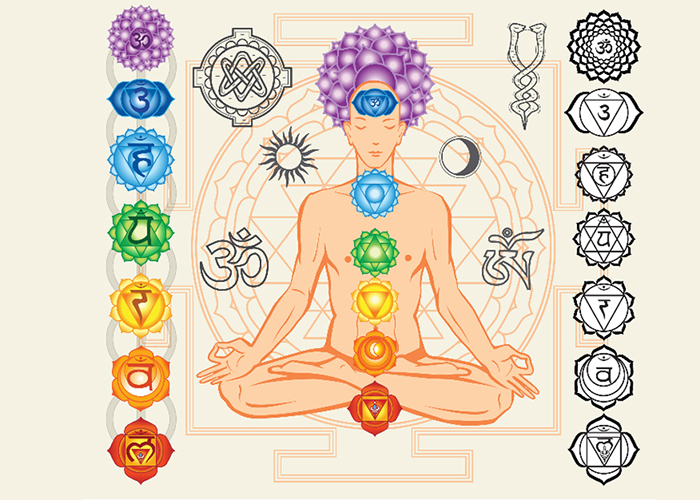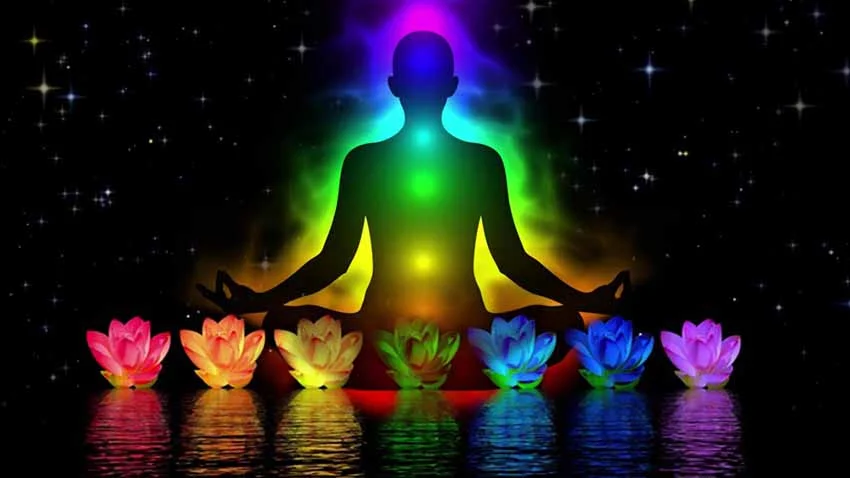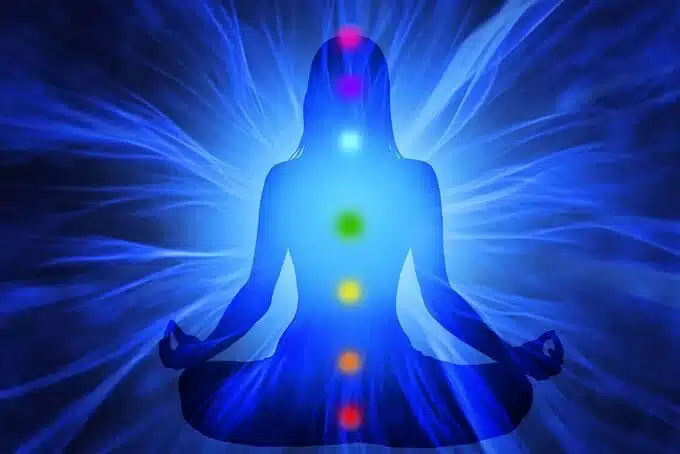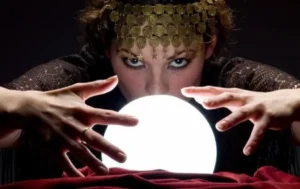For many people, the concept of chakras may be entirely new, while for others, especially those who practice yoga, it is a familiar term. Do you know! Our bodies possess energy centers that connect us to our environment and the universe.
Each individual can receive varying energy frequencies and vibrations. To facilitate the flow of energy in and out of the body, there are gateways called chakras. Among numerous energy centers, there are seven major chakras that originate from the base of the spine and ascend to the top of the head. So, what exactly are chakras, and how can one unlock them within the human body? In this article, LotusBuddhas invite you to explore and gain a deeper understanding of chakras with us.
What are Chakras?
Chakras are fascinating energy centers within our body that play a pivotal role in our physical, mental, and spiritual well-being. Originating from ancient Indian philosophy and often featured in yoga and meditation practices, the concept of chakras offers a unique perspective on the interconnection between our body and mind.
In total, there are seven main chakras aligned along the spine, starting from the base and moving up to the crown of the head. Each chakra corresponds to specific physical, emotional, and spiritual states, influencing various aspects of our lives.
- Root Chakra (Muladhara): Located at the base of the spine, the root chakra is associated with grounding, stability, and basic needs. When balanced, it fosters a sense of security and a strong foundation for life.
- Sacral Chakra (Svadhisthana): Positioned just below the navel, this chakra is linked to creativity, sexuality, and emotions. A balanced sacral chakra enables us to enjoy life fully and embrace change.
- Solar Plexus Chakra (Manipura): This chakra is situated in the stomach area and is connected to self-confidence, identity, and personal power. When in harmony, it empowers us to pursue our goals confidently.
- Heart Chakra (Anahata): Located in the center of the chest, the heart chakra governs love, compassion, and connection. A balanced heart chakra allows us to experience deep love for ourselves and others.
- Throat Chakra (Vishuddha): This chakra is found in the throat and is associated with communication and self-expression. When open, it enables us to express our truth and listen genuinely to others.
- Third Eye Chakra (Ajna): Positioned on the forehead between the eyes, this chakra is related to intuition and insight. A balanced third eye chakra helps us to see beyond the superficial and understand deeper truths.
- Crown Chakra (Sahasrara): At the very top of the head, the crown chakra connects us to the divine and the universe. When aligned, it fosters spiritual connection and enlightenment.
Balancing these chakras is believed to enhance physical, emotional, and spiritual harmony. Techniques such as meditation, yoga, and the use of crystals or essential oils are often employed to align and maintain the health of the chakras.
LotusBuddhas will share with you detailed information about each chakra and how to balance them in another article. For now, let us explore the meaning of the 7 chakras in the human body!
Meaning of 7 Chakras in the Body
1. Root Chakra (Muladhara)

| Characteristic | Description |
|---|---|
| Sanskrit Name | Muladhara |
| Location | At the base of the spine, in the coccygeal region |
| Associated Color | Red |
| Element | Earth |
| Symbol | A four-petaled lotus with a square and a downward-pointing triangle |
| Associated Body Parts | Spine, legs, feet, large intestine, adrenal glands |
| Key Qualities | Stability, survival, physical health, prosperity, trust |
| Emotional Issues | Fear, anxiety, insecurity, survival concerns |
| Balanced State | Feeling grounded, secure, connected to the earth, and capable of stillness and patience |
| Imbalanced State | Fearfulness, resistance to change, insecurity, disconnectedness from the body, materialism |
| Mantra | “LAM” |
Root Chakra, also known as Muladhara in Sanskrit, is the first of the seven primary chakras in the human energy system. Situated at the base of the spine, near the coccyx or tailbone, it forms the foundation of our energy system and is associated with the color red and the element of earth. Its name is derived from two Sanskrit words: “Mula,” meaning “root” or “base,” and “Adhara,” meaning “support” or “foundation.”
Muladhara is responsible for our sense of stability, security, and grounding. It governs our most basic needs, such as food, shelter, and safety, and is closely connected to our physical and emotional well-being. When the Root Chakra is balanced and functioning optimally, it helps us feel secure, grounded, and confident in our ability to navigate the challenges of life.
An imbalanced or blocked Root Chakra may manifest in various physical, emotional and mental issues. These can include anxiety, insecurity, fearfulness, materialism, or an inability to trust oneself or others. Physically, it may be linked to problems in the lower back, legs, feet and the immune system.
2. Sacral Chakra (Swadhisthana)

| Characteristic | Description |
|---|---|
| Sanskrit Name | Svadhishthana |
| Location | Located in the lower abdomen, about two inches below the navel and two inches in |
| Associated Color | Orange |
| Element | Water |
| Symbol | A six-petaled lotus with a white crescent moon |
| Associated Body Parts | Reproductive organs, kidneys, bladder, circulatory system |
| Key Qualities | Creativity, pleasure, sexuality, emotional fluidity, adaptability |
| Emotional Issues | Guilt, pleasure, sexuality, creativity, control |
| Balanced State | Ability to take risks, creative, committed, sexually vibrant, outgoing, emotionally intelligent |
| Imbalanced State | Sexual dysfunction, fear of pleasure or change, emotional instability, lack of creativity or passion |
| Mantra | “VAM” |
Sacral Chakra known as Svadhisthana in Sanskrit, is the second of the seven primary chakras in the human energy system. Located just below the navel in the lower abdomen, it is associated with the color orange and the element of water. The term “Svadhisthana” comes from two Sanskrit words: “Swa”, meaning “one’s own” or “self,” and “Adhisthana,” meaning “abode” or “dwelling place.”
Svadhisthana governs our creativity, sensuality, and emotional expression. It is responsible for our ability to experience pleasure, form connections with others and embrace change. A balanced Sacral Chakra allows us to be open to new experiences, cultivate healthy relationships, and express our emotions in a harmonious manner.
An imbalanced or blocked Sacral Chakra may lead to various emotional, mental and physical issues. These can include emotional instability, difficulty forming or maintaining relationships, a lack of creativity, sexual dysfunction, or feelings of guilt and shame. Physically, it may be related to problems with the reproductive system, lower back pain, or urinary tract issues. Engaging in creative activities, cultivating nurturing connections, and embracing change can also contribute to a balanced and healthy Svadhisthana.
3. Solar Plexus Chakra (Manipura)

| Characteristic | Description |
|---|---|
| Sanskrit Name | Manipura |
| Location | In the solar plexus area (upper part of the belly, where your diaphragm rests) |
| Associated Color | Yellow |
| Element | Fire |
| Symbol | A ten-petaled lotus with a downward-pointing triangle enclosing a t-shaped figure |
| Associated Body Parts | Digestive system, liver, pancreas |
| Key Qualities | Personal power, self-esteem, willpower, responsibility, reliability, confidence |
| Emotional Issues | Self-esteem issues, self-criticism, fear of rejection, oversensitivity to criticism |
| Balanced State | Feeling of inner harmony, self-acceptance, respect for the nature of oneself and others, feeling of inner peace |
| Imbalanced State | Low self-esteem, lack of willpower, fear of rejection, oversensitivity to criticism, lack of ambition |
| Mantra | “RAM” |
Solar Plexus Chakra, known as Manipura in Sanskrit, is the third of the seven primary chakras in the human energy system. Located in the upper abdomen around the area of the diaphragm, it is associated with the color yellow and the element of fire. The term “Manipura” is derived from two Sanskrit words: “Mani,” meaning “gem” or “jewel,” and “Pura,” meaning “city” or “place.”
Manipura governs our personal power, self-esteem, and assertiveness. It is responsible for our ability to take decisive action, set boundaries, and express our authentic selves. A balanced Solar Plexus Chakra enables us to have a strong sense of self, confidence in our abilities, and the motivation to pursue our goals and aspirations.
An imbalanced or blocked Solar Plexus Chakra may manifest in various emotional, mental, and physical issues. These can include feelings of powerlessness, low self-esteem, difficulty making decisions, or a tendency to be overly controlling or aggressive. Physically, it may be related to digestive problems, liver issues, or chronic fatigue.
Fostering self-awareness, setting healthy boundaries, and engaging in activities that promote personal growth and self-confidence can also contribute to a balanced and healthy Manipura.
4. Heart Chakra (Anahata)
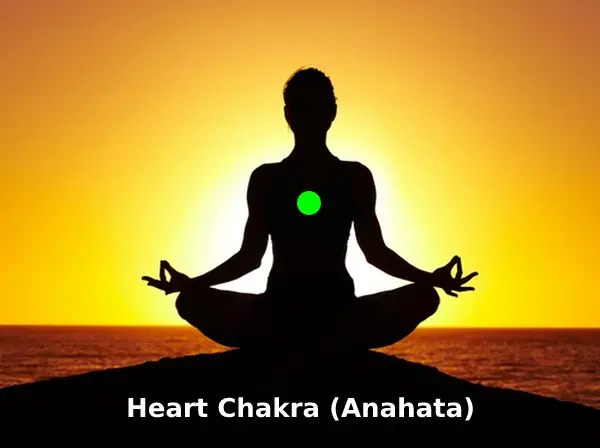
| Characteristic | Description |
|---|---|
| Sanskrit Name | Anahata |
| Location | Center of the chest, just above the heart |
| Associated Color | Green |
| Element | Air |
| Symbol | A twelve-petaled lotus with a hexagram (two interlaced triangles forming a six-pointed star) |
| Associated Body Parts | Heart, lungs, upper chest, shoulders, arms |
| Key Qualities | Love, compassion, altruism, empathy, forgiveness, harmony |
| Emotional Issues | Love (for self and others), relationships, compassion, forgiveness, trust |
| Balanced State | Unconditional love, forgiveness, compassion, balanced relationships, inner peace |
| Imbalanced State | Difficulty with love, lack of hope, despair, jealousy, fear of intimacy, loneliness, heart disease |
| Mantra | “YAM” |
Heart Chakra known as Anahata in Sanskrit, is the fourth of the seven primary chakras in the human energy system. Located at the center of the chest, near the physical heart, it is associated with the color green and the element of air. The term “Anahata” is derived from the Sanskrit words “an,” meaning “not” or “un,” and “ahata,” meaning “struck” or “beaten,” signifying its association with an unstruck or unwounded state of being.
Anahata governs our capacity for love, compassion, and emotional balance. It is responsible for our ability to form deep connections with others, empathize with their feelings, and express unconditional love. A balanced Heart Chakra enables us to experience a sense of inner peace, forgiveness, emotional harmony with ourselves and others.
An imbalanced or blocked Heart Chakra may manifest in various emotional, mental, and physical issues. These can include feelings of jealousy, resentment, lack of self-love, difficulty trusting others, or an inability to let go of past emotional wounds. Physically, it may be related to problems with the heart, lungs, or circulatory system. Engaging in acts of self-care, forgiveness, and compassion, as well as forming nurturing relationships, can also contribute to a balanced and healthy Anahata.
5. Throat Chakra (Vishuddha)

| Characteristic | Description |
|---|---|
| Sanskrit Name | Vishuddha |
| Location | Throat area |
| Associated Color | Light blue or turquoise |
| Element | Ether (also referred to as “Space”) |
| Symbol | A sixteen-petaled lotus with a circle containing a downward-pointing triangle |
| Associated Body Parts | Throat, neck, thyroid gland, vocal cords, respiratory system |
| Key Qualities | Communication, self-expression, truth, integrity, wisdom, diplomacy, artistic expression |
| Emotional Issues | Communication, self-expression, fear of no power or control, honesty, wisdom, truth |
| Balanced State | Open and clear communication, active listening, truthful expression, creativity, peace of mind |
| Imbalanced State | Communication issues, fear of speaking, poor listening skills, gossiping, lying, throat issues |
| Mantra | “HAM” |
Throat Chakra known as Vishuddha in Sanskrit, is the fifth of the seven primary chakras in the human energy system. Located at the throat, it is associated with the color blue and the element of ether or space. The term “Vishuddha” is derived from two Sanskrit words: “vi,” meaning “distinct” or “pure,” and “shuddha,” meaning “clear” or “purified,” signifying its association with clarity and purity of expression.
Vishuddha governs communication, self-expression and truth. It is responsible for our ability to express our thoughts, feelings, and ideas effectively, as well as to listen to and understand the perspectives of others. A balanced Throat Chakra enables us to speak with honesty, clarity, and confidence, fostering open and authentic communication in our personal and professional relationships.
An imbalanced or blocked Throat Chakra may manifest in various emotional, mental, and physical issues. These can include difficulty expressing oneself, fear of speaking up, dishonesty, or an inability to listen effectively. Physically, it may be related to problems with the throat, thyroid, neck, or vocal cords.
6. Third Eye Chakra (Ajna)

| Characteristic | Description |
|---|---|
| Sanskrit Name | Ajna |
| Location | Forehead, between the eyebrows |
| Associated Color | Indigo |
| Element | Light |
| Symbol | A two-petaled lotus with a downward-pointing triangle enclosing a circle with a point in the center |
| Associated Body Parts | Eyes, base of skull, brow |
| Key Qualities | Intuition, insight, awareness, inner guidance, clarity, wisdom, imagination |
| Emotional Issues | Intuition, fear of truth, confusion, judgement, insight, self-realization, open-mindedness |
| Balanced State | Clear vision, intuition, perception beyond dualism, wisdom, ability to see the big picture |
| Imbalanced State | Lack of clarity, confusion, rejection of spirituality, overanalyzing, illusion, blindness, headaches |
| Mantra | “OM” or “AUM” |
Third Eye Chakra, known as Ajna in Sanskrit, is the sixth of the seven primary chakras in the human energy system. Located between the eyebrows, slightly above the bridge of the nose, it is associated with the color indigo and the element of light. The term “Ajna” is derived from the Sanskrit word “Agya,” meaning “command” or “perception,” signifying its association with intuition, insight, and inner guidance.
Ajna governs our intuition, imagination, and ability to see beyond the physical realm. It is responsible for our capacity to perceive and interpret subtle energies, access higher states of consciousness, and connect with our inner wisdom. A balanced Third Eye Chakra enables us to cultivate a strong sense of intuition, develop psychic abilities, and experience greater clarity in our thoughts and decision-making.
An imbalanced or blocked Third Eye Chakra may manifest in various emotional, mental, and physical issues. These can include confusion, lack of clarity, difficulty concentrating, or an inability to trust one’s intuition. Physically, it may be related to problems with the eyes, sinuses, or headaches. Engaging in activities that promote inner reflection, intuition development, and mental clarity can also contribute to a balanced and healthy Ajna.
7. Crown Chakra (Sahasrara)

| Characteristic | Description |
|---|---|
| Sanskrit Name | Sahasrara |
| Location | Top of the head |
| Associated Color | Violet or white |
| Element | Thought or pure consciousness |
| Symbol | A thousand-petaled lotus |
| Associated Body Parts | Brain, nervous system |
| Key Qualities | Enlightenment, spiritual connection, self-knowledge, universal consciousness, wisdom |
| Emotional Issues | Spirituality, selflessness, enlightenment, peace, divine wisdom |
| Balanced State | Enlightened, universal, self-knowing, wise, aware of the world around us, spiritually connected |
| Imbalanced State | Spiritual cynicism, learning difficulties, rigid thought patterns, apathy, materialism, greed |
| Mantra | “OM” or “AUM” |
Crown Chakra known as Sahasrara in Sanskrit, is the seventh and final primary chakra in the human energy system. Located at the top of the head, it is associated with the color violet or sometimes white, and the element of pure consciousness. The term “Sahasrara” is derived from two Sanskrit words: “Sahasra,” meaning “thousand,” and “ara,” meaning “petal,” signifying its depiction as a thousand-petaled lotus and its connection to the highest state of spiritual awareness.
Sahasrara governs our spiritual connection, enlightenment, and unity with the cosmos. It is responsible for our ability to access higher states of consciousness, transcend the limitations of the ego, and experience oneness with all that exists. A balanced Crown Chakra enables us to cultivate a deep sense of inner peace, spiritual wisdom, and divine connection.
An imbalanced or blocked Crown Chakra may manifest in various emotional, mental and physical issues. These can include feelings of disconnection, spiritual disinterest, lack of inspiration, or an inability to access one’s higher self. Physically, it may be related to problems with the nervous system, brain function, or psychological disorders.
What Causes Chakras to be Blocked?
Chakras can become blocked or imbalanced due to a variety of factors, impacting our overall well-being. These energy centers are sensitive to our emotions, thoughts, and physical health, and when they are not in harmony, it can lead to feelings of discomfort, emotional upheaval, or physical symptoms. Here’s a look at some common causes that can lead to chakra blockages:
- Emotional Upheaval: Strong emotions, whether they stem from current situations or past traumas, can significantly affect our chakras. For instance, unresolved anger or grief can block the heart chakra, while fear can destabilize the root chakra.
- Stress and Anxiety: Chronic stress and persistent anxiety can disrupt the flow of energy through our chakras. The constant state of alertness and tension can constrict the energy flow, particularly in the solar plexus chakra, which deals with our sense of personal power and self-esteem.
- Negative Beliefs and Thought Patterns: Our chakras are also influenced by our thoughts and beliefs. Negative self-talk or limiting beliefs can obstruct the energy flow in chakras such as the throat chakra, which governs self-expression, or the third eye chakra, which relates to our intuition and perception.
- Physical Illness or Injury: Just as our mental and emotional states can affect our chakras, our physical health can also have an impact. An injury or illness in a specific part of the body can lead to a blockage in the corresponding chakra. For example, respiratory issues can affect the heart chakra, while digestive problems can impair the solar plexus chakra.
- Lifestyle Choices: Our daily habits and lifestyle choices, such as poor diet, lack of exercise, or insufficient rest, can contribute to chakra imbalances. These factors can deplete our energy and create blockages, particularly in the sacral and root chakras, which are associated with physical vitality and grounding.
- Environmental Influences: Our surroundings and the energy of places or people we interact with can also influence our chakras. Chaotic environments, negative people, or exposure to electronic devices can disrupt the harmony of our energy centers.
To maintain chakra balance, it’s important to address these causes through mindful practices such as meditation, yoga, and self-reflection. Engaging in activities that nourish the body, mind, and spirit can help to clear blockages and restore the flow of energy, promoting overall health and well-being.
How to Unblock Your Chakras
Unblocking your chakras is a journey toward inner balance and harmony. When energy flows freely through your chakras, you’re likely to feel more grounded, connected, and in tune with yourself. Here are some practical steps and techniques to help you unblock and realign your chakras:
- Meditation and Visualization: Regular meditation can significantly help in unblocking chakras. Focus on each chakra, starting from the root and moving up to the crown. Visualize energy flowing freely through each center. Use color visualization (each chakra has a corresponding color) to enhance the meditation’s effectiveness.
- Yoga: Specific yoga poses can activate and balance different chakras. For example, grounding poses like Tadasana (Mountain Pose) can help stabilize the root chakra, while heart-opening poses like Ustrasana (Camel Pose) can enhance the heart chakra’s flow.
- Breathing Exercises (Pranayama): Breathing techniques can be powerful tools for clearing blockages. For example, alternate nostril breathing can help balance and unblock the third eye and crown chakras.
- Sound Healing: Each chakra is associated with specific sound frequencies or mantras. Chanting these mantras or listening to these frequencies can help restore balance. For instance, the sound ‘LAM’ is associated with the root chakra, and focusing on this sound can help ground and stabilize your energy.
- Aromatherapy and Essential Oils: Certain essential oils can help activate and balance different chakras. For instance, sandalwood or myrrh can be beneficial for the root chakra, while lavender or white lotus can assist in opening the crown chakra.
- Crystal Therapy: Crystals resonate with the energy of the chakras. Placing a specific crystal on its corresponding chakra while lying down can help clear blockages. For example, red jasper can be used for the root chakra, and amethyst is great for the crown chakra.
- Nutrition: Consuming certain foods can help balance specific chakras. Root vegetables are good for the root chakra, while fruits high in antioxidants can benefit the heart chakra.
- Nature Connection: Spending time in nature and grounding yourself can help clear the root chakra, promoting a sense of stability and connectedness to the earth.
- Affirmations: Positive affirmations can reinforce the health of your chakras. For example, affirming “I am loved” can support the heart chakra, while “I am connected to my intuition” can benefit the third eye chakra.
- Seeking Professional Guidance: Sometimes, guidance from a healer or therapist experienced in chakra work can provide tailored support and techniques for unblocking and balancing your energy centers.
You must to remember that the concept of chakras, their activation, and unblocking is fundamentally spiritual and metaphysical in nature. These practices are not recognized or substantiated by conventional Western medical science. Therefore, while they may be seen as contributing to one’s overall well-being from the perspective of these spiritual traditions, they should not replace professional medical advice or treatment when required.
The Benefits When Chakras are Balanced
When your chakras are balanced, it’s like having a smooth, flowing river of energy inside you, connecting your physical, emotional, and spiritual aspects harmoniously. This balance can profoundly impact various areas of your life, offering a multitude of benefits that enhance your overall well-being. Let’s delve into the advantages you experience when your chakras are aligned and functioning optimally:
- Physical Health and Vitality: Each chakra is associated with specific organs and bodily functions. When they are balanced, it supports the optimal performance of these physical aspects, contributing to better health and vitality. For instance, a balanced root chakra can enhance your sense of stability and security, while a harmonious throat chakra can improve communication and self-expression.
- Emotional Equilibrium: Balanced chakras contribute to a stable and harmonious emotional state. You’re better equipped to handle stress, navigate challenges, and process your feelings effectively. For example, an open heart chakra fosters the ability to give and receive love freely, enhancing your relationships and connection with others.
- Mental Clarity and Focus: When your chakras are aligned, it facilitates clearer thinking and improved concentration. The third eye chakra, in particular, is linked to intuition and insight, helping you to see beyond the surface and understand deeper truths.
- Enhanced Creativity and Expression: The sacral chakra is the center of creativity and pleasure. When it’s balanced, you feel inspired and free to express your true self, engaging in creative pursuits with enthusiasm and joy.
- Spiritual Connection and Growth: The crown chakra, located at the top of the head, connects you to the divine and the universe. A balanced crown chakra can enhance your spiritual awareness, fostering a sense of peace, oneness, and enlightenment.
- Improved Relationships: Balanced chakras influence how you interact with others, promoting empathy, understanding, and effective communication. This can lead to healthier and more fulfilling relationships, both personally and professionally.
- Self-awareness and Personal Development: Working on your chakras encourages introspection and self-discovery, helping you to understand your desires, fears, and the patterns that shape your life. This awareness is a powerful tool for personal growth and transformation.
Balanced chakras are the foundation for a vibrant, fulfilling life. They enable you to navigate the world with confidence, grace, and a deep sense of inner harmony. By nurturing your chakras, you invest in your well-being, unlocking your potential to live fully and authentically.


